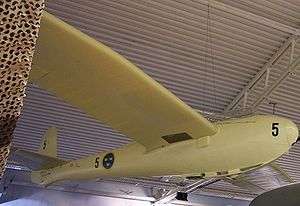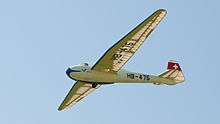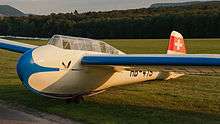DFS Kranich
The DFS Kranich is a type of German glider. It was developed by Hans Jacobs for the Deutsche Forschungsanstalt für Segelflug (DFS).
| Kranich | |
|---|---|
 | |
| An AB Flygplan Se-103, a Swedish licence-built Kranich. | |
| Role | Two-seat sailplane |
| Manufacturer | Karl Schweyer AG (primary manufacturer) |
| Designer | Hans Jacobs for DFS |
| First flight | 1935 |
| Variants | SZD-C Żuraw |
History
Series production of the Kranich (Crane) took place in the aircraft division of Karl Schweyer AG in Mannheim. The two-seater was, in its version 2, the most widely built two-seat glider in Germany from 1935 to 1939. Several hundred examples were built; exact numbers are not known.
On 11 October 1940 Erich Klöckner in a Kranich achieved the record height in a glider of 11,460 m (37598 ft). Because it occurred in wartime, the altitude record was not recognized by the Allied occupying powers, and Klöckner only received official recognition by the Fédération Aéronautique Internationale (FAI) in the late 1990s.[1] This record height was only exceeded ten years after the flight by the American Bill Ivans during a similar scientific program in the Sierra Nevada.
In 1942 30 Kranichs were built by the Swedish manufacturer AB Flygplan in Norrköping, and delivered to the Swedish Air Force for training purposes. These machines were given the military designation Flygplan Se 103.
Between 1950 and 1952 50 examples of a slightly modified copy of the Kranich II were built in Poland, known as the SZD-C Żuraw (żuraw is Kranich in Polish = "crane").
After the war, Jacobs designed the Kranich III, a new development very different from its predecessors. It was developed and produced at the Focke-Wulf aircraft factory in Bremen. The first flight was on 1 May 1952, piloted by Hanna Reitsch. Thirty-seven were built.
Variants

- Kranich
- The initial prototype designed by Hans Jacobs for the DFS.
- Kranich II
- Production aircraft built primarily by Karl Schweyer AG and by Mraz, Czechoslovakia, but also in Poland, Spain and Sweden
- Flygplan Se 103
- License production of 30 aircraft in Sweden for the Swedish Air Force
- SZD-C Żuraw
- License production of a modified Kranich in Poland
- Focke-Wulf Kranich III
- A major re-design.
Specifications (Kranich II)

Data from The World's Sailplanes:Die Segelflugzeuge der Welt:Les Planeurs du Monde[2]
General characteristics
- Crew: 2
- Length: 7.7 m (25 ft 3 in)
- Wingspan: 18 m (59 ft 1 in)
- Wing area: 22.7 m2 (244 sq ft)
- Aspect ratio: 14.3
- Airfoil: Göttingen 535
- Empty weight: 185 kg (408 lb) (equipped)
- Max takeoff weight: 350 kg (772 lb)
Performance
- Never exceed speed: 175 km/h (109 mph, 94 kn)
- Rough air speed max: 128 km/h (79.5 mph; 69.1 kn)
- Aerotow speed: 100 km/h (62.1 mph; 54.0 kn)
- Winch launch speed: 80 km/h (49.7 mph; 43.2 kn)
- Maximum glide ratio: 23.6 at 70 km/h (43.5 mph; 37.8 kn)
- Rate of sink: 0.7 m/s (140 ft/min) at 60 km/h (37.3 mph; 32.4 kn)
- Wing loading: 19.4 kg/m2 (4.0 lb/sq ft)
Notes
- aerokurier magazine 1/1999: Erich Klöckners Vorstoß zur Tropopause, Motor Presse 1999
- Shenstone, B.S.; K.G. Wilkinson; Peter Brooks (1958). The World's Sailplanes:Die Segelflugzeuge der Welt:Les Planeurs dans Le Monde (in English, French, and German) (1st ed.). Zurich: Organisation Scientifique et Technique Internationale du Vol a Voile (OSTIV) and Schweizer Aero-Revue. pp. 91–94.
References
- Shenstone, B.S.; K.G. Wilkinson; Peter Brooks (1958). The World's Sailplanes:Die Segelflugzeuge der Welt:Les Planeurs dans Le Monde (in English, French, and German) (1st ed.). Zurich: Organisation Scientifique et Technique Internationale du Vol a Voile (OSTIV) and Schweizer Aero-Revue. pp. 91–94.
Further reading
- Horst Lommel: Vom Höhenaufklärer bis zum Raumgleiter 1935 – 1945, Geheimprojekte der DFS, Motorbuch Verlag, Stuttgart 2000, ISBN 3-613-02072-6
- aerokurier magazine 1/1999: Erich Klöckners Vorstoß zur Tropopause, Motor Presse 1999
- Georg Brütting; Die berühmtesten Segelflugzeuge, Motorbuch Verlag, Stuttgart 2003, ISBN 3-613-02296-6
- Horst Lommel: Zeitschrift Luftfahrt History Nr. 4: Der Flieger Erich - ein Nachruf auf Erich Klöckner, Lautec Software und Medien GmbH, Siegen 2004
- Peter F. Selinger (2004), Segelflugzeug-Geschichten: die Gleit- und Segelflugzeuge des Deutschen Segelflugmuseums mit Modellflug auf der Wasserkuppe (in German), Gersfeld/Rhön: Stiftung Deutsches Segelflugmuseum Wasserkuppe mit Modellflug, ISBN 3-00-011649-4
External links
| Wikimedia Commons has media related to DFS Kranich. |
- Das Virtuelle Luftfahrtmuseum: Technische Daten, visited on 2 March 2009
- Deutsches Segelflugmuseum: 1935–1950, visited on 2 March 2009